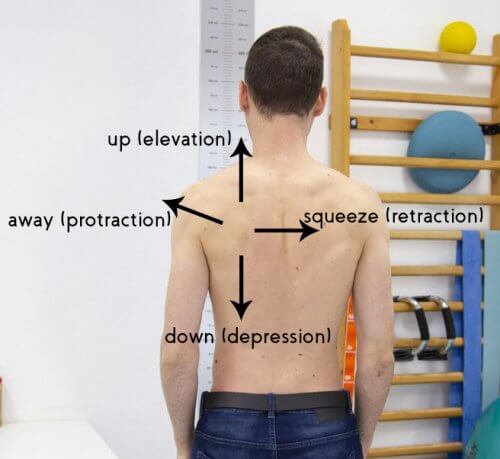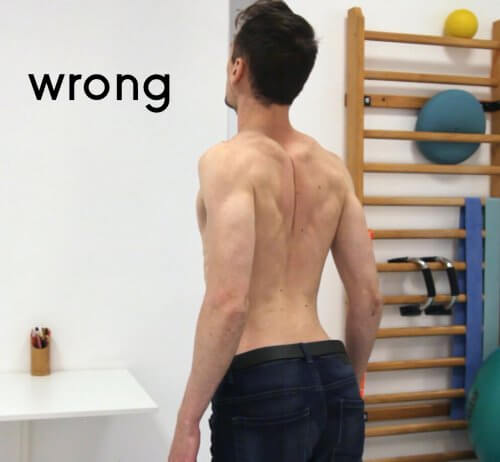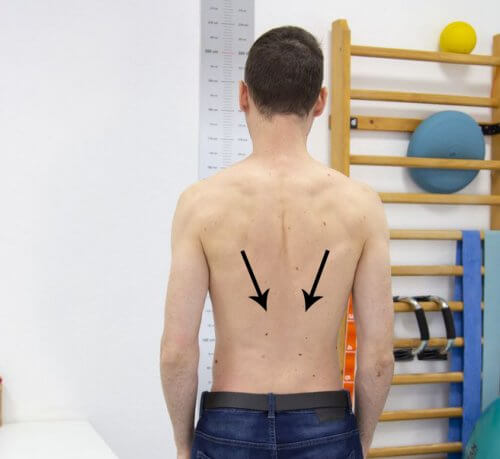lesson content in text
The shoulder blade, or scapula, controls how the shoulder moves, and where its neutral position is. Its optimal functioning is fundamental for providing stability, safety and strength.

We are now going to learn about how it moves, and then a simple exercise that will help you move your shoulder back into a more neutral, healthy position. And let me just say that this is vastly superior to the old instructions like ’stand up straight! Shoulders back! Chest forward!’, because most of the time these just make you compensate from your lower back. You’ll see why in a few minutes.
So let’s begin by exploring the 4 main directions in which the shoulder blade can move. These are:
- Up (called elevation)
- Down (called depression)
At this point you might think that you can’t see a thing because of my t-shirt, and you are right, so I’m going to have to take it off…

So, up and down (yes, pulling the shoulder blades down is called depression). The next 2 are:
- Protraction (away from the spine)
- Retraction (towards the spine)
These move your shoulders forward and backward. Try them all out and see how they feel. And once you are done, try connecting them by making some shoulder circles backwards.
Of these 4 directions, we are going to utilize 2 in the next exercise, namely depression (which is downward) and retraction (which is backward movement) because together, these put the shoulder into a safe, stable, healthy and better looking position.
- You can do this sitting down or standing up, but for now, stand up. It’s a good idea to stand in front of a mirror to see what you are doing.
- Pull your shoulder blades closer together, which is called retraction. You can think about squeezing a pack of guitar strings between them just to stay on topic.
- It might be easier to feel the correct position if you move your shoulder blades in the opposite direction as well, which is protraction. There’s a bigger difference, so it will be easier to notice.
- Now, while you are squeezing your shoulder blades together, pull them down. In other words, depress them. As you can see in the video, you will lose some retraction, but that’s fine. Here, you can think about putting the right shoulder blade into the left back pocket, and your left shoulder into the right back pocket. This position, made of retraction and depression, is called ’packed shoulders’, and it’s anatomically the most healthy, stable and well-functioning position of the whole shoulder girdle.

- As you move your shoulders, watch for any compensatory movement in your back, especially in your lower back. Most people will do something like this, extending their lower back and sticking out their butt. And now that you became aware of this ’cheating’, prevent it from happening by leaning against a doorway or a pillar, so that your spine is supported but your shoulders can move freely. Alternatively, you can sit down. Or just simply stand and keep an eye out for any compensation, and make sure you are only moving your shoulder blades.

After finishing a set, you should feel the muscles between the shoulder blades work. If you feel tension in your neck, it means that you unintentionally raised your shoulders, so pay close attention when you pull them down, and make sure you are doing it properly.
If you’ve got the hang of this exercise, then it’s time to progress to the next one, because while the above is a good start, it allows for some errors. For geeks: it allows the latissimus to work instead of the lower trapezius muscle. And we really want to turn on the lower trapezius.
So how do we do that? By folding the arms. If you try to do the previous exercise with folded arms, you cannot compensate at all – the right muscles will turn on. Of course, this makes this version much, much harder to do. As you can see, even I struggle to achieve a good range of motion. So be patient. There’s no need for huge movements – 1-2 cm (or less than an inch) is enough if it comes from the right muscles.

In the first few days, do the regular version, then this one with the folded arms. 15-30 reps, 2-3 times a day. If you have problematic or hunched shoulders, do 30 reps 3 times at once, and if you don’t, then much less is enough, like 15 reps a day.

